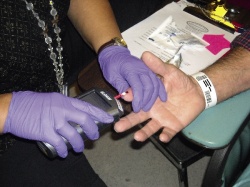Point-of-care-testing in emergency departments
Advice: test, test and test again
Over the past 10 years the use of point-of-care testing (POCT) in in European and North American hospitals has steadily increased, stimulated by the objectives of accelerating diagnostic treatment, increasing efficiency and improving patient outcomes, Cynthia E. Keen reports


Its use, however, remains controversial. Last month the American Association for Clinical Chemistry (AACC) conducted a three-day online conference on the role of POCT in patient care.
For many hospitalised patients, point of care testing begins in an emergency department (ED). In one conference session, a pathologist and a supervisor of POC services for two different multi-facility healthcare enterprises discussed how their organisations used POCT and what needed to be done when implementing a POCT programme in an emergency department.
Dr Valerie Ng, PhD, Chair of pathology for Alameda Health System, is also director of clinical medicine at Highland General Hospital, one of the seven healthcare facilities in the California county east of San Francisco Bay. She believes that the adversarial attitude about POCT that existed between laboratory and hospital departments has changed dramatically in the last five years. ‘There’s a role for POCT in emergency departments.’
Most hospital emergency departments are seriously overcrowded. If a POC test is performed appropriately and accurately according to protocol, if trained members of staff are available, if turnaround time for results is faster, and if the POCT achieves a goal that can be financially justified, Dr Ng is in favour. POCT can help make an ED function more efficiently and help improve patient outcomes.
It also can seriously harm or kill a patient, such as when the blood type of a patient needing a transfusion is mixed up with another patient. ‘It just doesn’t succeed without thorough analysis and preparation. Much work needs to be done to determine if a specific POCT procedure is appropriate. Some will be. Others won’t – and don’t assume that having an electronic medical record system will make things easier. Electronic records actually complicate the process because transactions with every element must be tested and validated,’ Dr Ng cautioned.
The two key points to consider are how quickly a result is needed. Will POCT decrease a patient’s length of stay? How will it affect patient management? Sonya Evans, POC coordinator of Greenville Health Systems, with six hospitals located across some 280 kilometres in northwest Georgia, agrees.
Her organisation established a multidisciplinary POC Committee to assure standardisation, clinical utility of any POC test, cost effectiveness, and clinical staff/regulatory compliance. Written policies and procedures are mandatory and enforced by both organisations, as well as standardised training. Staff members who don’t complete training updates are electronically ‘locked out’ of access to electronic POC testing forms.
The use of a POC D-dimmer test to exclude pulmonary embolism was an example given. ED physicians at Dr Ng’s hospital opt for a three-to-six hour rule out rather than a 90-minute one. For this reason, that test is performed by the central lab. Using POCT to identify elevated lactate that indicates sepsis is different. Speed in treatment is of the essence, not only for patient survival but also, in the USA, to meet federal metrics that determine financial performance incentive payments or penalties.
The ease of performing a POCT must also be evaluated, as well as the precision required to achieve accurate results. Only lab professionals should administer some tests, Ms Evans advises. Equipment or test kits may not function as well in A&E as in a lab.
The cost of a test must be evaluated against reimbursement and its value to patient and hospital. A POC creatinine test is more expensive, but has rapid turnaround. For this reason, the additional cost can be justified for a patient who needs a MRI exam. Efficient workflow without scheduling delays in a MRI suite is very important and worth the higher POCT cost.
Other advice: test, test and test again. Review all procedures with the staff members who will be performing the POCT to determine obstacles or hidden pitfalls before the implementation date. Monitor often and consistently. Be prepared to make adjustments immediately – and test them – when points of failure are identified. Use written procedures. Develop checklist forms. Establish metrics for on-going measurement. Train, train and retrain. Involve the IT staff if electronic records are involved. Make sure that data transfer from point-to-point-to-point are comprehensive and accurate and that everyone who needs to see the data has electronic access to it.
Finally, keep hospital administration informed. Otherwise, budgets may be affected.
18.11.2013











